Program on Science, Technology and Society at HarvardHarvard Kennedy School of Government | Harvard University |
|||||||
|
|
BooksBelow is a list of recent and forthcoming books by fellows and affiliates of the Program on Science, Technology and Society at the John F. Kennedy School of Government at Harvard University. For a more complete list of fellows’ publications, see the individual fellow pages in our people section. 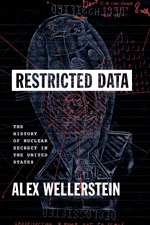 Restricted Data: The History of Nuclear Secrecy in the United StatesAlex WellersteinUniversity of Chicago Press, 2021.
The American atomic bomb was born in secrecy. From the moment scientists first conceived of its possibility to the bombings of Hiroshima and Nagasaki and beyond, there were efforts to control the spread of nuclear information and the newly discovered scientific facts that made such powerful weapons possible. The totalizing scientific secrecy that the atomic bomb appeared to demand was new, unusual, and very nearly unprecedented. It was foreign to both American science and American democracy—and potentially incompatible with both. From the beginning, this secrecy was controversial, and it was always contested. The atomic bomb was not merely the application of science to war, but the result of decades of investment in scientific education, infrastructure, and global collaboration. If secrecy became the norm, how would science survive?
Drawing on troves of declassified files, including records released by the government for the first time through the author’s efforts, Restricted Data traces the complex evolution of the US nuclear secrecy regime from the first whisper of the atomic bomb through the mounting tensions of the Cold War and into the early twenty-first century. A compelling history of powerful ideas at war, it tells a story that feels distinctly American: rich, sprawling, and built on the conflict between high-minded idealism and ugly, fearful power.
 American Trip: Set, Setting, and the Psychedelic Experience in the Twentieth CenturyIdo HartogsohnMIT Press, 2020.Are psychedelics invaluable therapeutic medicines, or dangerously unpredictable drugs that precipitate psychosis? Tools for spiritual communion or cognitive enhancers that spark innovation? Activators for one's private muse or part of a political movement? In the 1950s and 1960s, researchers studied psychedelics in all these incarnations, often arriving at contradictory results. In American Trip, Ido Hartogsohn examines how the psychedelic experience in midcentury America was shaped by historical, social, and cultural forces—by set (the mindset of the user) and setting (the environments in which the experience takes place). He explores uses of psychedelics that range from CIA and military experimentation to psychedelic-inspired styles in music, fashion, design, architecture, and film. Along the way, he introduces us to a memorable cast of characters including Betty Eisner, a psychologist who drew on her own experience to argue for the therapeutic potential of LSD, and Timothy Leary, who founded the Harvard Psilocybin Project and went on to become psychedelics' most famous advocate.
Hartogsohn chronicles these developments in the context of the era's cultural trends, including the cold war, the counterculture, the anti-psychiatric movement, and the rise of cybernetics. Drawing on insights from the study of science, technology, and society, he develops the idea of LSD as a suggestible technology, the properties of which are shaped by suggestion. He proposes the concept of collective set and setting, arguing that the historical and sociocultural context of midcentury America offered a particular set and setting—creating the conditions for what he calls the American trip. More information is available at https://mitpress.mit.edu/books/american-trip Making Time on MarsZara MirmalekMIT Press, 2020.
In 2004, mission scientists and engineers working with NASA's Mars Exploration Rovers (MER) remotely operated two robots at different sites on Mars for ninety consecutive days. An unusual feature of this successful mission was that it operated on Mars time—the daily work was organized across three sites on two planets according to two Martian time zones. In Making Time on Mars, Zara Mirmalek shows that this involved more than a resetting of wristwatches; the team's struggle to synchronize with Mars time involved technological and communication breakdowns, informal workarounds, and extra work to support the technology that was intended to support people. Her account of how NASA created an entirely new temporality for the MER mission offers insights about the assumptions behind the organizational relationship between clock time and work.
Mirmalek, herself a member of the mission team, offers an insider's view of the MER workplace and community. She describes the discord among MER's multiple temporalities and examines issues of professional identity that helped shape the experience of working according to Mars time. Considering time and work relationships through a multidisciplinary lens, Mirmalek shows how contemporary and historical human–technology relationships inform assumptions about the unalterability of clock time. She argues that the organizational connection between clock time and work, although still operational, is outdated.
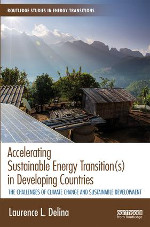 Accelerating Sustainable Energy Transition(s) in Developing Countries: The challenges of climate change and sustainable developmentLaurence DelinaRoutledge, 2018.Accelerating sustainable energy transitions away from carbon-based fuel sources needs to be high on the agendas of developing countries. It is key in achieving their climate mitigation promises and sustainable energy development objectives. To bring about rapid transitions, simultaneous turns are imperative in hardware deployment, policy improvements, financing innovation, and institutional strengthening. These systematic turns, however, incur tensions when considering the multiple options available and the disruptions of entrenched power across pockets of transition innovations. These heterogeneous contradictions and their trade-offs, and uncertainties and risks have to be systematically recognized, understood, and weighed when making decisions. This book explores how the transitions occur in fourteen developing countries and broadly surveys their technological, policy, financing, and institutional capacities in response to the three key aspects of energy transitions: achieving universal energy access, harvesting energy efficiency, and deploying renewable energy. The book shows how fragmented these approaches are, how they occur across multiple levels of governance, and how policy, financing, and institutional turns could occur in these complex settings.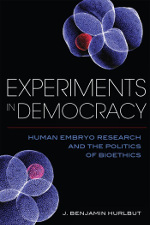 Experiments in Democracy Human Embryo Research and the Politics of BioethicsJ. Benjamin HurlbutColumbia University Press, 2017.Human embryo research touches upon strongly felt moral convictions, and it raises such deep questions about the promise and perils of scientific progress that debate over its development has become a moral and political imperative. From in vitro fertilization to embryonic stem cell research, cloning, and gene editing, Americans have repeatedly struggled with how to define the moral status of the human embryo, whether to limit its experimental uses, and how to contend with sharply divided public moral perspectives on governing science.
Experiments in Democracy presents a history of American debates over human embryo research from the late 1960s to the present, exploring their crucial role in shaping norms, practices, and institutions of deliberation governing the ethical challenges of modern bioscience. J. Benjamin Hurlbut details how scientists, bioethicists, policymakers, and other public figures have attempted to answer a question of great consequence: how should the public reason about aspects of science and technology that effect fundamental dimensions of human life? Through a study of one of the most significant science policy controversies in the history of the United States, Experiments in Democracy paints a portrait of the complex relationship between science and democracy, and of U.S. society's evolving approaches to evaluating and governing science's most challenging breakthroughs. More information is available at https://cup.columbia.edu/book/experiments-in-democracy/9780231179546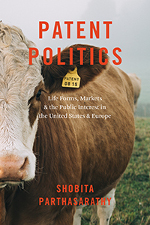 Patent Politics: Life Forms, Markets, and the Public Interest in the United States and EuropeShobita ParthasarathyUniversity of Chicago Press, 2017.Over the past thirty years, the world’s patent systems have experienced pressure from civil society like never before. From farmers to patient advocates, new voices are arguing that patents impact public health, economic inequality, morality—and democracy. These challenges, to domains that we usually consider technical and legal, may seem surprising. But in Patent Politics, Shobita Parthasarathy argues that patent systems have always been deeply political and social.
To demonstrate this, Parthasarathy takes readers through a particularly fierce and prolonged set of controversies over patents on life forms linked to important advances in biology and agriculture and potentially life-saving medicines. Comparing battles over patents on animals, human embryonic stem cells, human genes, and plants in the United States and Europe, she shows how political culture, ideology, and history shape patent system politics. Clashes over whose voices and which values matter in the patent system, as well as what counts as knowledge and whose expertise is important, look quite different in these two places. And through these debates, the United States and Europe are developing very different approaches to patent and innovation governance. Not just the first comprehensive look at the controversies swirling around biotechnology patents, Patent Politics is also the first in-depth analysis of the political underpinnings and implications of modern patent systems, and provides a timely analysis of how we can reform these systems around the world to maximize the public interest. More information is available at https://www.press.uchicago.edu/ucp/books/book/chicago/P/bo25338584.html The Creation of Markets for Ecosystem Services in the United StatesMattijs van MaasakkersAnthem Press, 2016.“This is a thoughtful and engaging history of the often misguided attempts to create markets for ecosystem services in the US and a guide to more participatory institutions that might work significantly better. Essential reading for anyone interested in ecosystem services.” —Robert Costanza, Chair in Public Policy, Crawford School of Public Policy, The Australian National University
The Creation of Markets for Ecosystem Services in the United States is a detailed, critical analysis of the most advanced efforts to create ecosystem services markets in the United States. With the help of in-depth case studies of three well-known attempts to create such markets––in the Chesapeake Bay watershed, the Ohio River basin and the Willamette River basin––the book explains why very few of these markets have actually succeeded even after close to two decades of much scholarly enthusiasm, significant federal funding and concerted efforts by NGOs, government agencies and private businesses.
Based on interviews, policy analysis and participatory observation, three features of markets for ecosystem services emerge as particularly problematic. First, the logic of displacement or the idea that particular elements of an ecosystem can be separated, quantified and traded across landscapes or watersheds runs counter to political interests, environmental beliefs and people’s connections to specific places. The second problem is that of measurement. By highlighting the long and often contentious histories of specific measurement systems used in ecosystem services markets, van Maasakkers shows that these quantification methods embed a range of assumptions and decisions about what counts when conserving or restoring (parts of) ecosystems. The third problem is related to participation in environmental decision-making. Since the requirements to buy offsets stem from federal and sometimes state regulations (based on the Clean Water Act or the Endangered Species Act), the opportunities and requirements for public participation are much more in line with typical policy implementation processes as opposed to voluntary decisions about buying and selling in an ideal typical market. How meaningful participation in this hybrid form of regulatory market is possible is not clear and not something that the proponents of markets have successfully dealt with, if at all. More information is available at https://anthempress.com/the-creation-of-markets-for-ecosystem-services-in-the-united-states-hb Who Owns the Dead? The Science and Politics of Death at Ground ZeroJay D. AronsonHarvard University Press, 2016.After September 11, with New Yorkers reeling from the World Trade Center attack, Chief Medical Examiner Charles Hirsch proclaimed that his staff would do more than confirm the identity of the individuals who were killed. They would attempt to identify and return to families every human body part recovered from the site that was larger than a thumbnail. As Jay D. Aronson shows, delivering on that promise proved to be a monumentally difficult task. Only 293 bodies were found intact. The rest would be painstakingly collected in 21,900 bits and pieces scattered throughout the skyscrapers’ debris.
This massive effort—the most costly forensic investigation in U.S. history—was intended to provide families conclusive knowledge about the deaths of loved ones. But it was also undertaken to demonstrate that Americans were dramatically different from the terrorists who so callously disregarded the value of human life.
Bringing a new perspective to the worst terrorist attack in U.S. history, Who Owns the Dead? tells the story of the recovery, identification, and memorialization of the 2,753 people killed in Manhattan on 9/11. For a host of cultural and political reasons that Aronson unpacks, this process has generated endless debate, from contestation of the commercial redevelopment of the site to lingering controversies over the storage of unclaimed remains at the National 9/11 Memorial and Museum. The memory of the victims has also been used to justify military activities in the Middle East that have led to the deaths of an untold number of innocent civilians. More information is available at https://www.hup.harvard.edu/catalog.php?isbn=9780674971493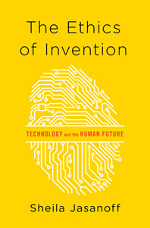 The Ethics of Invention: Technology and the Human FutureSheila JasanoffW.W. Norton and Company, 2016.We live in a world increasingly governed by technology—but to what end?
Technology rules us as much as laws do. It shapes the legal, social, and ethical environments in which we act. Every time we cross a street, drive a car, or go to the doctor, we submit to the silent power of technology. Yet, much of the time, the influence of technology on our lives goes unchallenged by citizens and our elected representatives. In The Ethics of Invention, renowned scholar Sheila Jasanoff dissects the ways in which we delegate power to technological systems and asks how we might regain control.
Our embrace of novel technological pathways, Jasanoff shows, leads to a complex interplay among technology, ethics, and human rights. Inventions like pesticides or GMOs can reduce hunger but can also cause unexpected harm to people and the environment. Often, as in the case of CFCs creating a hole in the ozone layer, it takes decades before we even realize that any damage has been done. Advances in biotechnology, from GMOs to gene editing, have given us tools to tinker with life itself, leading some to worry that human dignity and even human nature are under threat. But despite many reasons for caution, we continue to march heedlessly into ethically troubled waters.
As Jasanoff ranges across these and other themes, she challenges the common assumption that technology is an apolitical and amoral force. Technology, she masterfully demonstrates, can warp the meaning of democracy and citizenship unless we carefully consider how to direct its power rather than let ourselves be shaped by it. The Ethics of Inventionmakes a bold argument for a future in which societies work together—in open, democratic dialogue—to debate not only the perils but even more the promises of technology. More information is available at https://books.wwnorton.com/books/The-Ethics-of-Invention/ Strategies for Rapid Climate Mitigation: Wartime Mobilisation as a Model for Action?Laurence DelinaRoutledge, 2016.To keep the global average temperature from rising further than 2°C, emissions must peak soon and then fall steeply.This book examines how such rapid mitigation can proceed – in the scale and speed required for effective climate action – using an analogy provided by the mobilisation for a war that encompassed nations, the Second World War. Strategies for Rapid Climate Mitigation examines the wartime-climate analogy by drawing lessons from wartime mobilisations to develop contingency plans for a scenario where governments implement stringent mitigation programs as an ‘insurance policy’ where we pay for future benefits. Readers are provided a picture of how these programs could look, how they would work, what could trigger them, and the challenges in execution. The book analyses in detail one plausible approach to a crucial issue – an approach built upon knowledge of climate science and on proven and demonstrated mitigation measures. The book is meshed with a social and political analysis that draws upon narratives of mobilisations during the war to meet a transnational threat, while also addressing the shortcomings of the analogy and its strategies. . Prisoners of Reason: Game Theory and Neoliberal Political EconomyS.M. AmadaeCambridge University Press, 2016.Is capitalism inherently predatory? Must there be winners and losers? Is public interest outdated and free-riding rational? Is consumer choice the same as self-determination? Must bargainers abandon the no-harm principle? Prisoners of Reason recalls that classical liberal capitalism exalted the no-harm principle. Although imperfect and exclusionary, modern liberalism recognized individual human dignity alongside individuals' responsibility to respect others. Neoliberalism, by contrast, views life as ceaseless struggle. Agents vie for scarce resources in antagonistic competition in which every individual seeks dominance. This political theory is codified in non-cooperative game theory; the neoliberal citizen and consumer is the strategic rational actor. Rational choice justifies ends irrespective of means. Money becomes the medium of all value. Solidarity and good will are invalidated. Relationships are conducted on a quid pro quo basis. However, agents can freely opt out of this cynical race to the bottom by embracing a more expansive range of coherent action. More information is available at https://www.cambridge.org/us/academic/subjects/politics-international-relations/political-theory/prisoners-reason-game-theory-and-neoliberal-political-economy?format=PB Dreamscapes of Modernity: Sociotechnical Imaginaries and the Fabrication of PowerSheila JasanoffUniversity of Chicago Press, 2015.Dreamscapes of Modernity offers the first book-length treatment of sociotechnical imaginaries, a concept originated by Sheila Jasanoff and developed in close collaboration with Sang-Hyun Kim to describe how visions of scientific and technological progress carry with them implicit ideas about public purposes, collective futures, and the common good. The book presents a mix of case studies—including nuclear power in Austria, Chinese rice biotechnology, Korean stem cell research, the Indonesian Internet, US bioethics, global health, and more—to illustrate how the concept of sociotechnical imaginaries can lead to more sophisticated understandings of the national and transnational politics of science and technology. A theoretical introduction sets the stage for the contributors’ wide-ranging analyses, and a conclusion gathers and synthesizes their collective findings. The book marks a major theoretical advance for a concept that has been rapidly taken up across the social sciences and promises to become central to scholarship in science and technology studies. More information is available at https://press.uchicago.edu/ucp/books/book/chicago/D/bo20836025.html Science and Democracy Making Knowledge and Making Power in the Biosciences and BeyondStephen Hilgartner, Clark Miller, Rob HagendijkRoutledge, 2015.In the life sciences and beyond, new developments in science and technology and the creation of new social orders go hand in hand. In short, science and society are simultaneously and reciprocally coproduced and changed. Scientific research not only produces new knowledge and technological systems but also constitutes new forms of expertise and contributes to the emergence of new modes of living and new forms of exchange. These dynamic processes are tightly connected to significant redistributions of wealth and power, and they sometimes threaten and sometimes enhance democracy. Understanding these phenomena poses important intellectual and normative challenges: neither traditional social sciences nor prevailing modes of democratic governance have fully grappled with the deep and growing significance of knowledge-making in twenty-first century politics and markets.
Building on new work in science and technology studies (STS), this book advances the systematic analysis of the coproduction of knowledge and power in contemporary societies. Using case studies in the new life sciences, supplemented with cases on informatics and other topics such as climate science, this book presents a theoretical framing of coproduction processes while also providing detailed empirical analyses and nuanced comparative work.
Science and Democracy: Knowledge as Wealth and Power in the Biosciences and Beyond will be interesting for students of sociology, science & technology studies, history of science, genetics, political science, and public administration. More information is available at https://www.routledge.com/books/details/9780415821346/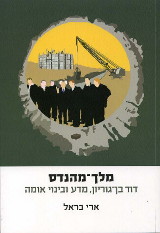 Engineer king: David Ben-Gurion, Science and Nation BuildingAri BarellBen-Gurion Research Institute Press, 2014.In Engineer king: David Ben-Gurion, Science and Nation Building (Ben-Gurion Research Institute Press, 2014), Ari Barell examines David Ben-Gurion's views and policies towards science and technology, and his relations with scientists and experts.The book follows the profound and symbiotic relations that developed between the emerging Israeli political center and the scientific establishments in the young country where Ben-Gurion served as the first Prime Minister. More information is available at https://in.bgu.ac.il/en/loeb/Pages/publications.aspx Routes of Power: Energy in Modern AmericaChristopher F. JonesHarvard University Press, 2014.The fossil fuel revolution is usually rendered as a tale of historic advances in energy production. In this perspective-changing account, Christopher F. Jones instead tells a story of advances in energy access—canals, pipelines, and wires that delivered power in unprecedented quantities to cities and factories at a great distance from production sites. He shows that in the American mid-Atlantic region between 1820 and 1930, the construction of elaborate transportation networks for coal, oil, and electricity unlocked remarkable urban and industrial growth along the eastern seaboard. But this new transportation infrastructure did not simply satisfy existing consumer demand—it also whetted an appetite for more abundant and cheaper energy, setting the nation on a path toward fossil fuel dependence. Between the War of 1812 and the Great Depression, low-cost energy supplied to cities through a burgeoning delivery system allowed factory workers to mass-produce goods on a scale previously unimagined. It also allowed people and products to be whisked up and down the East Coast at speeds unattainable in a country dependent on wood, water, and muscle. But an energy-intensive America did not benefit all its citizens equally. It provided cheap energy to some but not others; it channeled profits to financiers rather than laborers; and it concentrated environmental harms in rural areas rather than cities. Today, those who wish to pioneer a more sustainable and egalitarian energy order can learn valuable lessons from this history of the nation’s first steps toward dependence on fossil fuels. 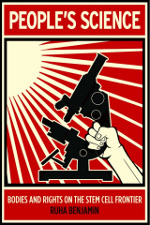 People's Science: Bodies and Rights on the Stem Cell FrontierRuha BenjaminStanford University Press, 2013.Stem cell research has sparked controversy and heated debate since the first human stem cell line was derived in 1998. Too frequently these debates devolve to simple judgments—good or bad, life-saving medicine or bioethical nightmare, symbol of human ingenuity or our fall from grace—ignoring the people affected. With this book, Ruha Benjamin moves the terms of debate to focus on the shifting relationship between science and society, on the people who benefit—or don't—from regenerative medicine and what this says about our democratic commitments to an equitable society.
People's Science uncovers the tension between scientific innovation and social equality, taking the reader inside California's 2004 stem cell initiative, the first of many state referenda on scientific research, to consider the lives it has affected. Benjamin reveals the promise and peril of public participation in science, illuminating issues of race, disability, gender, and socio-economic class that serve to define certain groups as more or less deserving in their political aims and biomedical hopes. Under the shadow of the free market and in a nation still at odds with universal healthcare, the socially marginalized are often eagerly embraced as test-subjects, yet often are unable to afford new medicines and treatment regimes as patients.
Ultimately, Ruha Benjamin argues that without more deliberate consideration about how scientific initiatives can and should reflect a wider array of social concerns, stem cell research— from African Americans' struggle with sickle cell treatment to the recruitment of women as tissue donors—still risks excluding many. Even as regenerative medicine is described as a participatory science for the people, Benjamin asks us to consider if "the people" ultimately reflects our democratic ideals. More information is available at https://www.sup.org/books/title/?id=20585 Counting Civilian Casualties: An Introduction to Recording and Estimating Nonmilitary Deaths in ConflictEdited by Taylor B. Seybolt, Jay D. Aronson, and Baruch FischhoffOxford University Press, 2013.A popular myth emerged in the late 1990s: in 1900, wars killed one civilian for every eight soldiers, while contemporary wars were killing eight civilians for every one soldier. The neat reversal of numbers was memorable, and academic publications and UN documents regularly cited it. The more it was cited, the more trusted it became. In fact, however, subsequent research found no empirical evidence for the idea that the ratio of civilians to soldiers killed in war has changed dramatically. But while the ratios may not have changed, the political significance of civilian casualties has risen tremendously.
Over the past century, civilians in war have gone from having no particular rights to having legal protections and rights that begin to rival those accorded to states. The concern for civilians in conflict has become so strong that governments occasionally undertake humanitarian interventions, at great risk and substantial cost, to protect strangers in distant lands. I n the early 1990s, the UN Security Council authorized military interventions to help feed and protect civilians in the Kurdish area of Iraq, Somalia, and Bosnia. And in May 2011 , Barack Obama 's National Security Advisor explained the United States' decision to support NATO's military intervention in these terms "When the president made this decision, there was an immediate threat to 700,000 Libyan civilians in the town of Benghazi. We've had a success here in terms of being able to protect those civilians."
Counting Civilian Casualties aims to promote open scientific dialogue by high lighting the strengths and weaknesses of the most commonly used casualty recording and estimation techniques in an understandable format. Its thirteen chapters, each authoritative but accessible to nonspecialists, explore a variety of approaches, from direct recording to statistical estimation and sampling, to collecting data on civilian deaths caused by conflict. The contributors also discuss their respective advantages and disadvantages, and analyze how figures are used (and misused) by governments, rebels, human rights advocates, war crimes tribunals, and others. In addition to providing analysts with a broad range of tools to produce accurate data, this will be an in valuable resource for policymakers, military officials, jou rnalists, human rights activists, courts, and ordinary people who want to be more informed--and skeptical--consumers of casualty counts.
More information is available at https://global.oup.com/academic/product/counting-civilian-casualties-9780199977307;jsessionid=441C7907EDA4C32CF60B0634C5956B3C?cc=us&lang=en& Reasons of Conscience: The Bioethics Debate in GermanySperling, StefanUniversity of Chicago Press, 2013.The implicit questions that inevitably underlie German bioethics are the same ones that have pervaded all of German public life for decades: How could the Holocaust have happened? And how can Germans make sure that it will never happen again? In Reasons of Conscience, Stefan Sperling considers the bioethical debates surrounding embryonic stem cell research in Germany at the turn of the twenty-first century, highlighting how the country’s ongoing struggle to come to terms with its past informs the decisions it makes today.
Sperling brings the reader unmatched access to the offices of the German parliament to convey the role that morality and ethics play in contemporary Germany. He describes the separate and interactive workings of the two bodies assigned to shape German bioethics—the parliamentary Enquiry Commission on Law and Ethics in Modern Medicine and the executive branch’s National Ethics Council—tracing each institution’s genesis, projected image, and operations, and revealing that the content of bioethics cannot be separated from the workings of these institutions. Sperling then focuses his discussion around three core categories—transparency, conscience, and Germany itself—arguing that without fully considering these, we fail to understand German bioethics. He concludes with an assessment of German legislators and regulators’ attempts to incorporate criteria of ethical research into the German Stem Cell Law. More information is available at https://www.press.uchicago.edu/ucp/books/book/chicago/R/bo14365130.html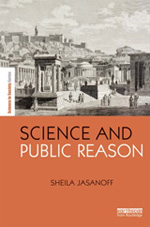 Science and Public ReasonSheila JasanoffRoutledge, 2012.This collection of essays by Sheila Jasanoff explores how democratic governments construct public reason, that is, the forms of evidence and argument used in making state decisions accountable to citizens. The term public reason as used here is not simply a matter of deploying principled arguments that respect the norms of democratic deliberation. Jasanoff investigates what states do in practice when they claim to be reasoning in the public interest. Reason, from this perspective, comprises the institutional practices, discourses, techniques and instruments through which governments claim legitimacy in an era of potentially unbounded risks—physical, political, and moral. Those legitimating efforts, in turn, depend on citizens’ acceptance of the forms of reasoning that governments offer. Included here therefore is an inquiry into the conditions that lead citizens of democratic societies to accept policy justification as being reasonable. These modes of public knowing, or “civic epistemologies,” are integral to the constitution of contemporary political cultures. More information is available at https://www.routledge.com/books/details/9780415524865/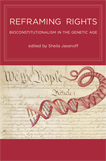 Reframing Rights: Bioconstitutionalism in the Genetic AgeEdited by Sheila JasanoffMIT Press, 2011.Legal texts have been with us since the dawn of human history. Beginning in 1953, life too became textual. The discovery of the structure of DNA made it possible to represent the basic matter of life with permutations and combinations of four letters of the alphabet, A, T, C, and G. Since then, the biological and legal conceptions of life have been in constant, mutually constitutive interplay--the former focusing on life's definition, the latter on life's entitlements. Reframing Rights argues that this period of transformative change in law and the life sciences should be considered "bioconstitutional." More information is available at https://mitpress.mit.edu/9780262516273/reframing-rights/Reframing Rights explores the evolving relationship of biology, biotechnology, and law through a series of national and cross-national case studies. Sheila Jasanoff maps out the conceptual territory in a substantive editorial introduction, after which the contributors offer "snapshots" of developments at the frontiers of biotechnology and the law. Chapters examine such topics as national cloning and xenotransplant policies; the politics of stem cell research in Britain, Germany, and Italy; DNA profiling and DNA databases in criminal law; clinical trials in India and the United States; the GM crop controversy in Britain; and precautionary policymaking in the European Union. These cases demonstrate changes of constitutional significance in the relations among human bodies, selves, science, and the state.  Les Politiques des Nanotechnologies: Pour un Traitement Démocratique d’une Science EmergenteBrice LaurentCharles Leopold Mayer, 2010.Since the early 1980's, Nanotechnology has made it possible to develop technological instrumentation capable of manipulating individual atoms, making a whole new world accessible to human intervention. Today, nanotechnology is commonly used in the production of various consumer products, ranging from cosmetics to food and medical research. Under the banner of "responsible innovation", programs with generous public support for nanotechnology aspire to take into account health-related, environmental and ethical issues in this emerging field. In this book, Brice Laurent focuses on the political questions brought on by nanotechnology and opens the trail for the renewal of the democratic treatment of these complex scientific innovations.
More information is available at https://www.eclm.fr/livre/les-politiques-des-nanotechnologies/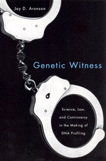 Genetic Witness: Science, Law, and Controversy in the Making of DNA ProfilingJay D. AronsonRutgers University Press, 2007.When DNA profiling was first introduced into the American legal system in 1987, it was heralded as a technology that would revolutionize law enforcement. As an investigative tool, it has lived up to much of this hype—it is regularly used to track down unknown criminals, put murderers and rapists behind bars, and exonerate the innocent. Yet, this promise took ten turbulent years to be fulfilled. In Genetic Witness, Jay D. Aronson uncovers the dramatic early history of DNA profiling that has been obscured by the technique's recent success. He demonstrates that robust quality control and quality assurance measures were initially nonexistent, interpretation of test results was based more on assumption than empirical evidence, and the technique was susceptible to error at every stage. Most of these issues came to light only through defense challenges to what prosecutors claimed to be an infallible technology. Although this process was fraught with controversy, inefficiency, and personal antagonism, the quality of DNA evidence improved dramatically as a result. Aronson argues, however, that the dream of a perfect identification technology remains unrealized. More information is available at https://www.rutgersuniversitypress.org/genetic-witness/9780813541884/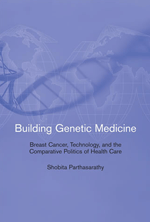 Building Genetic Medicine: Breast Cancer, Technology, and the Comparative Politics of Health CareShobita ParthasarathyMIT Press, 2007.In Building Genetic Medicine, Shobita Parthasarathy shows how, even in an era of globalization, national context is playing an important role in the development and use of genetic technologies. Focusing on the development and deployment of genetic testing for breast and ovarian cancer (known as BRCA testing) in the United States and Britain, Parthasarathy develops a comparative analysis framework in order to investigate how national "toolkits" shape both regulations and the architectures of technologies and uses this framework to assess the implications of new genetic technologies. BRCA testing was one of the most highly anticipated and publicized technologies of contemporary medicine. Parthasarathy argues that differences in the American and British approaches to health care and commercialization of research led to the establishment of different BRCA services in the two countries. In Britain, the technology was available through the National Health Service as an integrated program of counseling and laboratory analysis, and was viewed as a potentially cost-effective form of preventive care. In the United States, although BRCA testing was initially offered by a number of providers, one company eventually became the sole provider of a test available to consumers on demand. Parthasarathy also reports on an unsuccessful attempt by the American provider of BRCA testing to market its services in Britain. British scientists, health-care providers, and patients rejected the American technology, she argues, because it was part of a social, economic, and political system to which they were not accustomed. Parthasarathy draws lessons for the future of genetic medicine from these cross-national differences, and discusses the ways in which comparative case studies can inform policy-making efforts in science and technology. More information is available at https://direct.mit.edu/books/book/2710/Building-Genetic-MedicineBreast-Cancer-Technology Pharmacopolitics: Drug Regulation in the United States and GermanyArthur A. DaemmrichUniversity of North Carolina Press, 2006.Advocates of rapid access to medicines and critics fearful of inadequate testing both argue that globalization will supersede national medical practices and result in the easy transfer of pharmaceuticals around the world. In Pharmacopolitics, Arthur Daemmrich challenges their assumptions by comparing drug laws, clinical trials, and systems for monitoring adverse reactions in the United States and Germany, two countries with similarly advanced systems for medical research, testing, and patient care. Daemmrich proposes that divergent "therapeutic cultures"—the interrelationships among governments, patients, the medical profession, and the pharmaceutical industry—underlie national differences and explain variations in pharmaceutical markets and medical care. Daemmrich carries the United States-Germany comparison from 1950 to the present through case studies of Terramycin (an antibiotic), thalidomide (a sedative), propranolol (a heart medication), interleukin-2 (a cancer therapy), and indinavir (an AIDS drug). He points to different political constructions of "the patient" in the United States and Germany to clarify important differences in government policies and in the distribution of power among key social actors. Daemmrich advises that international regulatory harmonization and globalization in medicine must retain flexibility for social and political variation between countries, even as they achieve technical standardization. More information is available at https://uncpress.org/book/9780807872413/pharmacopolitics/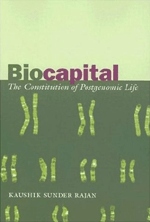 Biocapital: The Constitution of Postgenomic LifeKaushik Sunder RajanDuke University Press, 2006.Biocapital is a major theoretical contribution to science studies and political economy. Grounding his analysis in a multi-sited ethnography of genomic research and drug development marketplaces in the United States and India, Kaushik Sunder Rajan argues that contemporary biotechnologies such as genomics can only be understood in relation to the economic markets within which they emerge. Sunder Rajan conducted fieldwork in biotechnology labs and in small start-up companies in the United States (mostly in the San Francisco Bay area) and India (mainly in New Delhi, Hyderabad, and Bombay) over a five-year period spanning 1999 to 2004. He draws on his research with scientists, entrepreneurs, venture capitalists, and policymakers to compare drug development in the two countries, examining the practices and goals of research, the financing mechanisms, the relevant government regulations, and the hype and marketing surrounding promising new technologies. In the process, he illuminates the global flow of ideas, information, capital, and people connected to biotech initiatives. Sunder Rajan's ethnography informs his theoretically sophisticated inquiry into how the contemporary world is shaped by the marriage of biotechnology and market forces, by what he calls technoscientific capitalism. Bringing Marxian theories of value into conversation with Foucaultian notions of biopolitics, he traces how the life sciences came to be significant producers of both economic and epistemic value in the late twentieth century and early twenty-first. More information is available at https://www.dukeupress.edu/biocapital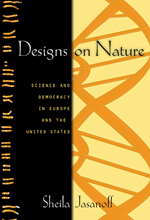 Designs on Nature: Science and Democracy in Europe and the United StatesSheila JasanoffPrinceton University Press, 2005.Biology and politics have converged today across much of the industrialized world. Debates about genetically modified organisms, cloning, stem cells, animal patenting, and new reproductive technologies crowd media headlines and policy agendas. Less noticed, but no less important, are the rifts that have appeared among leading Western nations about the right way to govern innovation in genetics and biotechnology. These significant differences in law and policy, and in ethical analysis, may in a globalizing world act as obstacles to free trade, scientific inquiry, and shared understandings of human dignity. More information is available at https://press.princeton.edu/books/paperback/9780691130422/designs-on-nature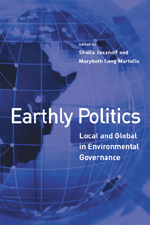 Earthly Politics: Local and Global in Environmental GovernanceEdited by Sheila Jasanoff and Marybeth Long MartelloMIT Press, 2004.Globalization today is as much a problem for international harmony as it is a necessary condition of living together on our planet. Increasing interconnectedness in ecology, economy, technology, and politics has brought nations and societies into ever closer contact, creating acute demands for cooperation. Earthly Politics argues that in the coming decades global governance will have to accommodate differences, even as it obliterates distance, and will have to respect many aspects of the local while developing institutions that transcend localism. More information is available at https://mitpress.mit.edu/9780262600590/earthly-politics/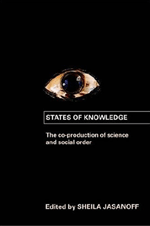 States of Knowledge: The Co-Production of Science and Social OrderEdited by Sheila JasanoffRoutledge, 2004 (paperback 2006).In the past twenty years, the field of science and technology studies (S&TS) has made considerable progress toward illuminating the relationship between scientific knowledge and political power. These insights have not yet been synthesized or presented in a form that systematically highlights the connections between S&TS and other social sciences. This timely collection of essays by some of the leading scholars in the field attempts to fill that gap. The book develops the theme of co-production, showing how scientific knowledge both embeds and is embedded in social identities, institutions, representations and discourses. Accordingly, the authors argue, ways of knowing the world are inseparably linked to the ways in which people seek to organize and control it. Through studies of emerging knowledges, research practices and political institutions, the authors demonstrate that the idiom of co-production importantly extends the vocabulary of the traditional social sciences, offering fresh analytic perspectives on the nexus of science, power and culture. More information is available at https://www.routledge.com/States-of-Knowledge-The-Co-production-of-Science-and-the-Social-Order/Jasanoff/p/book/9780415403290Contributors: Michel Callon, John Carson, Peter Dear, Michael Dennis, Yaron Ezrahi, Stephen Hilgartner, Sheila Jasanoff, Michael Lynch, Clark Miller, Vololona Rabeharisoa, William Storey, Charis Thompson, Claire Waterton, Brian Wynne.  Race to the Finish: Identity and Governance in an Age of GenomicsJenny ReardonPrinceton University Press, 2004.In the summer of 1991, population geneticists and evolutionary biologists proposed to archive human genetic diversity by collecting the genomes of "isolated indigenous populations." Their initiative, which became known as the Human Genome Diversity Project, generated early enthusiasm from those who believed it would enable huge advances in our understanding of human evolution. However, vocal criticism soon emerged. Physical anthropologists accused Project organizers of reimporting racist categories into science. Indigenous-rights leaders saw a "Vampire Project" that sought the blood of indigenous people but not their well-being. More than a decade later, the effort is barely off the ground. How did an initiative whose leaders included some of biology's most respected, socially conscious scientists become so stigmatized? How did these model citizen-scientists come to be viewed as potential racists, even vampires? This book argues that the long abeyance of the Diversity Project points to larger, fundamental questions about how to understand knowledge, democracy, and racism in an age when expert claims about genomes increasingly shape the possibilities for being human. Jenny Reardon demonstrates that far from being innocent tools for fighting racism, scientific ideas and practices embed consequential social and political decisions about who can define race, racism, and democracy, and for what ends. She calls for the adoption of novel conceptual tools that do not oppose science and power, truth and racist ideologies, but rather draw into focus their mutual constitution. More information is available at https://press.princeton.edu/books/paperback/9780691118574/race-to-the-finish |
||||||